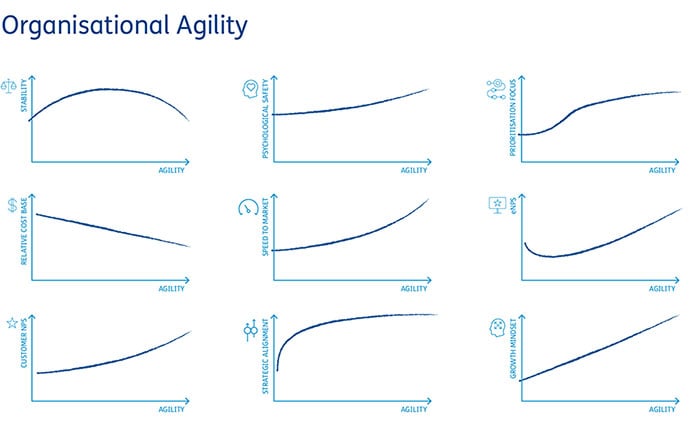
How frozen organisations can become fluid
6 March 2022
To develop organisational agility, focus on being like water
Take a moment to think about the properties of water:
- Water can flow. It’s formless.
- Water can create things, but it can also crash through barriers.
- Water underpins health.
Why does this matter? Because the properties of water are just like the characteristics we see in companies that have high degrees of agility.
Let’s explore what this can look like in practice…
Just as water can flow, truly agile organisations can seamlessly flow through value streams to deliver rapid change, rather than operating in vertical siloes. Additionally, a fluid organisational structure is enabled by self-organising communities that coalesce around a particular sprint, then disband and move on to the next priority. What’s more, as executive teams constantly prioritise the things that will deliver the greatest impact, their direction filters down throughout the organisation.
Just as water can crash through barriers, agile organisations disrupt the status quo. They break down siloes. They replace the traditional chain of command with an empowered organisation enabled by a collective growth mindset. They’ve stopped thinking in terms of ‘projects’ – instead, they focus on ‘outcomes’. Moreover, agile organisations overhaul traditional top-down management styles, and move decision-making authority to where the information resides. For example, if you’re looking for the optimal way to resolve a customer enquiry, it’s best to work with the call-centre agents who speak to hundreds of customers every day.
And just as water promotes health, a culture of organisational agility can nurture a flourishing business. A healthy organisation has a clear purpose. Unless executive teams have clarity on their strategic objectives, there’s no point trying to develop agility. In a healthy organisational culture, employees feel psychologically safe. In other words, they know their leaders won’t punish them if things go wrong. Furthermore, healthy innovation depends on people having enough unstructured time to explore new ideas. Think of companies like Google and Atlassian that allow staff to spend a portion of their time on side projects to spur innovation.
Right now, many businesses are frozen by operational rigidity. Developing organisational agility will allow them to flow again.
Why agility is important
Organisational agility should be a top priority for all executive teams. Today’s businesses are in a constant state of flux. The C-Suite community faces extreme volatility across three dimensions:
- Consumers’ needs and spending patterns are shifting continuously.
- The economic environment remains unpredictable.
- The future of work has changed irreversibly.
To manage this volatility, many leaders are looking to Agile methodologies. But Agile alone isn’t enough. Simply put, Agile is too fragile. To achieve meaningful results, organisations need to focus on agility. In other words, when companies adopt Agile, they also need to implement broader changes to their operating model, roles, skills and ways of working. That’s where the real challenges AND opportunities lie.
The immense power of organisational agility
Organisational agility is extremely powerful. It’s one of the only ways that companies can achieve speed, quality AND cost-effectiveness, without having to make trade-offs.
Here at Baringa, we take a unique combined approach to helping clients accomplish these goals.
We help clients improve speed by shaping a dual operating model. This sounds inefficient and overly complex, but it’s quite the opposite. Dual operating models keep the organisation’s existing structure, while in parallel multi-skilled teams form around core value streams. This flexible approach helps our clients be more responsive, accelerate innovation and dramatically cut their time-to-market.
We help clients improve quality by empowering them to make better business decisions. Often, this means decoupling decision-making from the traditional management structure/hierarchy. In addition, we help their leadership develop a coaching mindset, to better empower their teams.
We help clients cut costs by supporting them in the deployment of small releases that deliver incremental change. This approach reduces any potential cost of failure.
By delivering improvements in speed, quality and cost-effectiveness, agility impacts every aspect of the organisation…
How agility indicatively affects different KPIs across an organisation can be seen in these charts:
(click to enlarge image)
Key takeaways for the C-Suite
Organisational agility is elusive, so how can leadership teams develop it? We’ve put together a set of recommendations for the C-Suite.
Leadership teams need to adopt the mantra of ‘start less, finish more’. The key to successfully developing agility is to start small, think big, and go fast.
Furthermore, agility demands a different kind of governance. At Baringa, we talk about the concept of ‘tight/loose’. Instead of trying to control (be ‘tight’ on) everything, the C-Suite should concentrate on the few key metrics that will have the greatest impact on the organisation’s strategic purpose. This idea isn’t new, and many organisations already focus on a ‘critical few’ KPIs. The challenge is allowing yourself (and your teams) to be ‘loose’ on everything else. It is challenging to get this tight/loose balance right initially, but once achieved it will unlock huge swathes of capacity across the organisation.
Leadership teams need to focus on doing things ‘together or not at all’. This is about making sure that people trust their leaders and peers, so they feel confident to experiment and innovate together.
Finally, we need to raise an important point. Agile organisations are fluid, but they also require a degree of stability. This sounds counterintuitive, but it’s true. If companies develop agility and decide to change everything overnight without a stable centre of gravity, it results in chaos. Instead, the organisation needs a stable axis. Stability can take many different forms. It might be long-serving members of the leadership team, or self-forming communities spanning multiple organisational levels within a business. Alternatively, it could be a thin governance framework, or a regular sprint cadence. These small elements of stability help give structure and direction to a highly nimble workforce.
Unlearning old behaviours
To develop agility, leaders will have to unlearn old behaviours. We’ve already touched on some important points. For instance, we explained that leaders need to react well when things go wrong so that employees feel psychologically safe. We’ve also discussed replacing top-down hierarchies with decentralised decision-making, and shifting the focus from projects to outcomes.
Beyond this, leaders need to stop ‘protecting their turf’. This can be one of the greatest challenges in developing organisational agility. Unless executive teams learn to embrace a more fluid organisational structure, they can’t effect real change.
How to get started
Given the volatile business environment, it’s no surprise that many companies (and many consultancies) are talking about Agile and agility. However, it’s important to recognise that each business has a different approach to implementation.
We’ve put together three key pieces of advice for organisations looking to kick-start their agility. They show how Baringa’s approach differs from other consulting firms.
- Some consultancies advocate a ‘big bang’ approach. We don’t. ‘Big bang’ deployments are high-risk and hugely disruptive. We recommend our clients start with one value stream, achieve real results, then scale from there.
- Some consultants will suggest starting with the value stream that offers the biggest benefits. We don’t. Perhaps counterintuitively, we advise our clients to choose the value stream where the customer alignment is the strongest (ie making the initial implementation as easy as possible). Only once this is complete should an organisation move on to the more challenging value streams. This way, the rest of the organisation can rely upon the proven concept and a culture that has taken root. Remember that agility requires a degree of stability.
- Focus on your organisation’s key purpose, and make sure it filters down into everything you do. That includes the success metrics you use, the investments you make, and even the language you use with your business. Your purpose should be the North Star, guiding teams across the entire organisation as they evolve and transform the business.
Our Experts


Developing Organisational Agility
We’ve been working with leaders in enterprise organisations to transform their companies and harness the power and ingenuity of all their people to deliver great outcomes for their customers. We’re helping them embed the organisational structures, mind-sets and behaviours that enable the business to work at pace, while remaining in control. And we’re helping them form the fundamental building blocks that allow them to adapt to future challenges.
Related Insights

Organisational agility: a guide to taking the first steps
Our business agility and operational excellence expert Simon Tarbett offers some advice to clients when asked the question, Where To Start?
Read more
The need for agility to grow revenue and thrive in a turbulent market
We’re looking at how organisations need to be agile if they’re to grow revenue and thrive in a turbulent market.
Read more
How to set targets to drive business performance
Targets are essential for driving better business results. Let’s discuss what companies should – and shouldn’t – be doing.
Read more
Ruthless prioritisation
The secret to delivering a corporate strategy faster, more effectively and at lower cost
Read moreIs digital and AI delivering what your business needs?
Digital and AI can solve your toughest challenges and elevate your business performance. But success isn’t always straightforward. Where can you unlock opportunity? And what does it take to set the foundation for lasting success?
